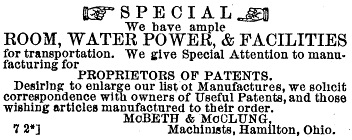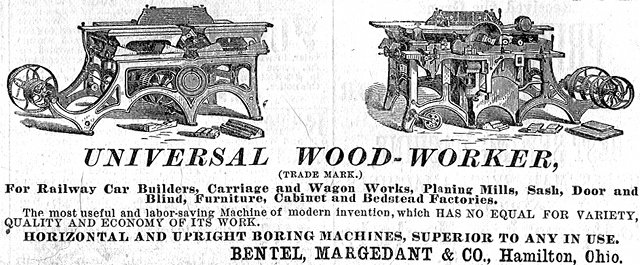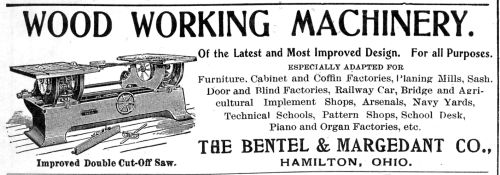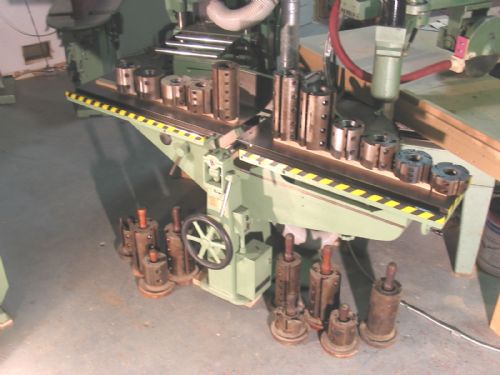Manufacturers Index - Bentel, Margedant & Co.
Bentel, Margedant & Co.
Hamilton, OH, U.S.A.
Manufacturer Class:
Wood Working Machinery
Last Modified: Mar 6 2019 12:07PM by Jeff_Joslin
If you have information to add to this entry, please
contact the Site Historian.
|
Overview
In 1860, journeyman machinist Charles E. McBeth moved to Hamilton, Ohio to join the firm of Lea & Leavitt, makers of sawmills and steam engines. He worked for that firm under contract until about 1864, when the firm ceased doing business. McBeth bought much of the assets and went into business for himself, manufacturing small agricultural articles such as corn stalk cutters and tobacco molds. In 1867 he was joined by D. W. McClung; they operated as McBeth & McClung. Finding their excellent manufacturing facilities under-used, they advertised for patent-holders to contract with them for manufacturing.

Ad from the August 25, 1867 issue of "Scientific American"
The ad was apparently successful because they were soon manufacturing a "Universal Wood Worker" that had been patented in 1866 by Henry Climer and John D. Riley of Cincinnati. This machine was the genesis of the modern jointer, and was to become the linch-pin of the business. More information on this important machine is given below.
In 1867 or 1868 McClung sold his interest to Jacob Shaffer, and in 1869 Shaffer sold his interest to William C. Margedant. The European-educated Margedant had been a machinist for Owens, Lane & Dyer from 1854 to 1859. After that Margedant worked as engineer and architect for a businessman named John W. Sohn.
In 1870 McBeth and Margedant were joined by Fred Bentel, and the firm became McBeth, Bentel & Margedant. At this point the firm was making tobacco molds and the Universal Wood Worker. The latter product was becoming very successful, and they increased their shop capacity, added a line of planers, and, with Henry Climer—John Riley having since died—made improvements to the Universal Wood Worker. They suffered a major setback in May of 1873, when a fire damaged the shop, destroying patterns and disrupting their production. The break in their cash flow made rebuilding difficult and contentious. McBeth left the partnership and was replaced by Margedant's old boss, John Sohn. The firm became Bentel, Margedant & Co.

Ad from the 27 September 1873 issue of "Scientific American"
After the firm built new patterns to replace those lost in the fire, Margedant developed a complete line of woodworking machinery which proved to be successful. A poor economy in 1876-1879 hurt their sales and caused financial difficulties for the partnership. Margedant and Bentel both sold their interests to Sohn, Margedant continuing with the business as a manager and designer.
In 1885 the name was changed to Bentel & Margedant Co. The business continued to prosper, with the firm gaining an excellent reputation, both for the regular line and for their "special machinery", which were custom-designed to fulfil specific needs such as manufacturing vehicle wheels and wood pumps. The Universal Wood-Worker continued to be a big seller, as did their line of machines for rail bar builders.

Ad from May 1889 issue of "The Woodworker"
The history becomes murky after 1900; apparently the company was fading into irrelevance. In December 1918 the company name was deregistered, which meant that it had ceased doing business.

Ad from the July 1900 issue of "Carpentry and Building"
The Universal Wood Worker

A later example of Bentel, Margedant & Co.'s Universal Wood Worker. More pictures of this machine can be seen in the Photo Index.
The Universal Wood Worker was the first machine that we would recognize as the modern jointer. In addition, various cutterheads could be substituted for the jointing head, to perform molding, rabbeting, dadoing, etc. Over first twenty years of its evolution, the Universal Wood Worker evolved into a machine specialized for jointing, as the shaping and molding functions were subsumed by more specialized machines.
Information Sources
- The 1869 Annual Report of the Ohio State Board of Agriculturelists McBeth & McClung as having won a Silver Medal ant $10 at that year's Nineteenth Ohio State Fair.
- The name "McBeth, Bentel & Margedant" was registered as a trademark for woodworking machinery on 1871-06-10 and issued 1871-07-18.
- 1872 and 1873 articles in Manufacturer & Builder referred to "McBeth, Bentel, & Margedant."
- Listed in the 1874 book, Wiley's American Iron Trade Manual of the Leading Iron Industries of the United States, under the mangled name of "McBeth, Morgatant & Co.": Wood-working machinery, tobacco machinery, etc."
- The 1874 Annual Report of the Boston Public Library lists Bentel, Margedant & Co. as having donated one volume to the library.
- Article in November 1874 Manufacturer & Builder.
- Article in the December 25, 1875 issue of Scientific American, on Buffington & Forney's patent wheelwright machine. Buffington and Forney contracted the manufacturing to Bentel, Margedant & Co.
- Listed in a work published by the United States Centennial Commission, Official Catalog of the 1876 International Exhibition:
Bentel, Margedant, & Co., Hamilton, O.—Universal wood-working machines. Planing and matching, jointing, band and scroll saws, boring and shaping machines. Bentel, Margedant, & Co. have on exhibition twelve different machines, each of them presenting new features, which are improvements, and add greatly to their value and usefulness, and are all first-class in mechanical construction. The patent universal wood-woodworkers for planing out of wind, jointing, squaring, smoothing, beveling, cornering, chamfering, tapering, mitreing, rabbeting, tenoning, halfing, panel-raising, tongueing, grooving, hand-matching, rolling-joints, gaining, plowing, serpentine and waved moulding, fluting, beading, ripping, splitting, cross-cut sawing, straight, circular, oval, and elliptical mouldings, dovetailing, etc. The patent band-sawing machine is, in its construction and improvements, new and highly valuable. This is a patent machine, the improvements on which are entirely new features. The mechanical cause of the breakage of band-saw blades unprecedentedly and successfully removed. The buckling, friction, heating, and crystallization of the saw-blades entirely overcome. Instantaneous starting and stopping of the motion of the saw-blade. The patent scroll saw machine with uniform tension is certain at all points of the stroke. The Hamilton patent surface planer for planing out of wind, joining, squaring, smoothing, beveling, cornering, chamfering, mitreing, and tapering, is furnished with patent triangular shear-knife cutter-heads. It planes both smoothly and accurately.
- The 1876 book, Draft-book of Centennial carriages, displayed in Philadelphia, at the International exhibition of 1876, contains the following listing for this company:
Bentel, Margedant & Co., Hamilton, O., also have a large exhibit in Machinery Hall, and show a variety of valuable wood-working machinery, similar in purposes to those above named [in the description of the J. A. Fay & Co. exhibit], including Universal Wood-workers, band and scroll saws, surface-planers, horizontal and vertical boring-machines, and one machine specially adapted for carriage-builders, known as "Buffington & Forney's Universal Wheelwrights' Machine," which planes wheel-rims on three sides when on the wheel, dressing sawed felloes high at the joints, and bent felloes to a true circle; planes material straight, out of wind, square, and to a thickness; saws off the spokes and cuts the tenons on any sized wheels, and also bores the felloes. In connection with their Patent universal Tables, this machine is very complete and valuable for wagons and wheel factories. The above-mentioned Buffington and Forney received four patents for their wheelwrights' machine, and these are listed in the patent section.
- An 1882 book, A History and Biographical Cyclopaedia of Butler County Ohio reports that in 1874, Charles E. McBeth sold his firm, McBeth & McClung, to Bentel, Margedant & Co. (McBeth then reportedly went to work for Long, Allstatter & Co., whose products included agricultural equipment if we are to judge by a patent, 134,831, granted to Robert Allstatter and assigned to Long & Allstatter.) This version of events mangles the relationship between McBeth & McClung and Bentel, Margedant & Co., but we accept their statement that McBeth later worked for Long & Allstatter.
- From The Railroad, Telegraph, and Steamship Builders' Directory, 1888: a listing under wood-working machinery for "Bentel, Margedant & Co., Hamilton, O."
- The Centennial Anniversary of the city of Hamilton, Ohio, 1891, ed. Col. D. W. McClung, has the following biography:
The Bentel & Margedant Co., Wood Working Machinery.
In 1864-65 Mr. Charles E. McBeth, a machinist in Hamilton, commenced the manufacture of small power presses, corn stalk cutters, tobacco molds, shoe polishers and other small articles. In 1867 D. W. McClung, and later Jacob Shaffer, entered into partnership with Mr. McBeth to manufacture the Universal Wood Worker. They had bought a half interest in the patent and also the control of the other half. Mr. McClung soon retired, selling to Shaffer and in 1869 Mr. Shaffer retired, selling to Mr. W. C. Margedant.
Mr Margedant, from 1854 to 1859 had been working as a journeyman machinist in the old shop of Owens, Lane & Dyer and leaving that shop had become engineer and architect for Mr. John W. Sohn who was engaged in numerous enterprises requiring the services of such a man. Mr. Margedant had had a thorough technical education in Europe and was a man of genius and energy. In 1870 Mr. Fred Bentel entered the concern. The firm was then manufacturing tobacco molds and the Universal Wood Worker. The Universal Wood Worker was a machine of a great deal of merit and demand for it grew so large that the capacity of the shop required to be greatly increased. But in May 1873 a fire occurred imposing a loss of over six thousand dollars. The loss was a hard one for it destroyed valuable patterns and made a serious break in the business on which the prosperity of the owners depended and they were very hard up for money when rebuilding was imperative. Disputes arose over the rebuilding and Mr. McBeth retired, Mr. John W. Sohn taking his place as an equal partner. The rebuilding was completed and new patterns were made and to the line of manufacturing was added a full line of wood working machinery of the very latest and most original design, Mr. Margedant proving himself to be possessed of most admirable talents in this direction. The business prospered until the dull times of 1876-1879 when things took a bad turn, business being wretched, and debts pressing. The pressure became too great and Mr. Margedant and Mr. Bentel both retired from the business, Mr. Sohn assuming the whole load and employing Mr. Margedant as manager on a salary with an interest in the profits. Business soon picked up and the capacity of the shop became over-taxed and it became necessary to work double turn night and day, and many orders were refused. Business relaxed again and it became necessary to make reductions at every point. But this depression passed over and business again picked up. In 1885 the concern was incorporated under the style of the Bentel & Margedant Co., Mr. Margedant becoming a stockholder. On January 11th, 1889, Mr. Sohn died and Mr. Margedant purchased his stock. In 1889 the business was re-organized with Mr. Margedant as President and general manager, Mr. John T. Gardner Vice President and Superintendent; and William L. Huber Secretary and Treasurer.
The business is in the best possible condition. Its products are known the world over and its machines are models of practical design and superior efficiency. The line of machines manufactured includes over three hundred different sizes and styles of regular machines, to say nothing of special machines which are being constantly devised for special work. In this line of special machines this establishment has a most brilliant reputation, it being well understood throughout the wood-working world that if some new and unheard of machine is wanted for specially economical and more perfect proficiency in the working of wood, the Bentel & Margedant Co., are always prepared to devise and construct it with the assurance that the result will be satisfactory in the highest degree. For instance, in the manufacture of vehicle wheels, where the closest economy and the greatest perfection in production is called for, the special machines of this establishment are the standard requirement. This automatic refined machinery is of the utmost refined character and deals with the rough wood and produces the finished wheel. A specialty has also been made of automatic machinery for the manufacture of wood pumps, and for railroad car works. An idea of the extensive product of this establishment may be gathered from the fact that of the "Universal Wood Work," a single machines in the long list of products of this concern, over four thousand have been sold and they have gone into all the lands where wood is worked
The shops are very extensive and are well equipped with the best modern iron-working machinery for the production of wood-working machines, and the business is conducted with the most careful and conscientious supervision with a constant thought as to the best interests of the customer.
- An 1895 invoice and a 1917 patent assignment give the company name as Bentel & Margedant Co.
- An article in the February 1898 issue of "American Machinist" features Bentel & Margedant Co.'s Universal Sawing Machine, which was a double-arbor tilting-table saw.
- Listed in C. H. Wendel's The Circular Sawmill, which reports on a circular sawmill advertised in an 1897 issue of "The Age of Steel." This sawmill was a specialized machine that carried the log on centers, and, with a special dividing attachment, a log could be cut into segments. Wendel says, "Much of the product from machines like this went into plow handles and other specialized wood products."
- From the Centennial History of Butler County, originally published 1905, reprinted by the Butler County Historical Society, author unknown.
One of the best known manufactories of Hamilton is the Bentel & Margedant Company, who have won a world-wide reputation as makers of wood-working machinery, the excellence of their product having enabled them to take first premium over all competitors wherever their machinery has been placed on exhibition. This company commenced the manufacture of their goods in 1864, but shortly afterwards the works were destroyed by fire. The works were, however, rebuilt on a larger scale than before and with better conveniences, and from that time on they have commanded a constantly expanding trade, until now they lead the world in their line. They employ nearly two hundred men and their product amounts to between three and four hundred thousand dollars annually. The book also contains biographies of McBeth and McClung:
Charles E. McBETH was born in Champaign County, Ohio, February 7, 1835, and is the oldest son of James and N. B. McBETH. He attended the common schools in his native county, then beginning to learn the machinist’s trade at Urbana when seventeen years old. He continued there and in Eastern cities, working as a journeyman, until coming to Hamilton, in the Fall of 1860, with Lee & Leavitt. He built circular saws and steam engines for them by contract for some years, until they discontinued business. He purchased the greater portion of it, and during the war conducted it under the firm name of McBeth & McClung, manufacturing wood-working machinery. They sold out to Bentel, Margedant & Co. in 1874. He then became a member of the firm of Long, Alstetter & Co., now a stock company, known as the Long & Alstetter Co., and has been its secretary and treasurer ever since. They are manufacturers of agricultural implements, power punches, and hammers. They employ about one hundred and fifty hands. Mr. McBETH was married on the 1st of June, 1864, to Miss Lizzie HUNTER, daughter of William HUNTER. They have two daughters, Mary M. and Anna. He and his wife are members of the Presbyterian Church.
David Waddle McCLUNG, surveyor of customs for the port of Cincinnati, is of West Scotland or Highland stock... [After the Civil War h]e returned to Hamilton, and was elected president of the Second National Bank, although not then a stockholder. In about a year and a half he resigned that place, and began the manufacture of machinery, in Hamilton, remaining in this business for two years, when he exchanged his stock in the machine-shop for an interest in the Woodsdale Paper Company, of which he took charge, and remained its business manager until February 1, 1879...
- Ohio State records show that "The Bentel and Margedant Co." name was registered 16 February 1885, and de-registered 27 December 1918.
- The May 1909 issue of American Engineer and Railroad Journal has a writeup on a vertical car boring machine from this maker. "The machine weighs 6,500 lbs, requires 10 horse-power for driving and occupies a floor space of 6 by 10 ft."
- The September 1910 issue of a magazine for automobile builders, The Hub, has an article on Bentel & Margedant Co.'s car "carriage shop machines". An accompanying ad from them, for their "Hamilton-Ohio-Line, Wood-Working Tools for Carriage, Wagon, Hub, Spoke, Rim, Wheel and Body Work" lists their products related to those specialties: sanders (disk, belt, spoke, wheel); gear machines (shapers, rounders); rim machines (planers, rounders, borers, cut-off saws); wheel machines (boring and screw driving); spoke machines (lathes, cut-off saws, tenoning and mitering machines, throaters, facers); hub machines (lathes, mortisers, borers); tire machines (truers, bolters). The ad also lists general-purpose machines (Band saws, rip and cross-cut saws, planers, matchers, moulders, shapers, boring machines, universal wood-workers.
- Used machines listed in 1917 catalog: "Auto traversing gaining machine"; "Auto gang dado or gaining machine"
- Carriage and Wagon Makers Machinery and Tools by Kenneth L. Cope, 2004 page 14
|